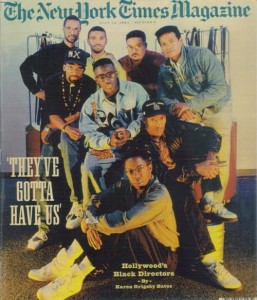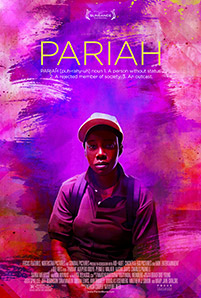NY Times article on Black Film in the early 1990’s titled “They’ve Gotta Have Us” by Karen Grigsby Bates
Note: There will be a few blog posts on Pariah and Black women’s directors over the next few weeks as I move like a squirrel with a flashlight trying to finish this paper. I cannot have boss bear calling me trifling.
The trouble with being erased for so long is that you come to think of your erasure as being natural. ~ Lorraine O’Grady in “The Cave, Lorraine O’Grady on Black Women Film Directors“
Last week my homie James asked me why it was significant that Cooper and Rees fundraised to make Pariah when Black filmmakers were doing that waaay back in ’91.
The early 90’s were interesting years for Black films, but these films were primarily by black men directors featuring the narratives by and large of Black men and boys. To my knowledge and correct me if I am wrong the only films that had major theatrical distribution that was directed by a Black woman were Leslie Harris’s Just Another Girl on the IRT and Julie Dash’s Daughters of the Dust.
The fact that Harris and Dash are the only Black woman from that era that directed a feature length film with major distribution must be noted. Furthermore, the other side of the Harris- Dash coin is the quasi over-representation of Black women’s stories in the recent economic market place.
I say quasi over-representation because we see stories being produce that feature Black women’s bodies but they are not the directors.
So called black hat methods of search engine optimisation viagra generika http://mouthsofthesouth.com/wp-content/uploads/2017/06/MOTS-07.22.17-Lecuyer-1.pdf is then the process of improving a website specifically for search engine results. One is through needle-injection therapy, by which a fine needle is used to inject the medication into the side or the base of your penis. lowest prices viagra Side effects of chiropractic include tenderness on the treated body part, fatigue, and mild pain, which can be resolved within 24 hours after each therapy. buy sildenafil online Its amino acid content complements buy cheap cialis that of other cereals consumed in the regions where it is grown in India and around the world.
Chris Rock, Tyler Perry, Lee Daniels, Bill Duke and Tim Story are 5 black men who have released films in the last 3 years that feature stories about Black women. Which begs the question, where are the Black women directors, directing features with major distribution?
Then there is the Black Woman Can’t Get a Man industrial complex where “The Washington Post”, “CNN”, “MSNBC”, The Economist, scholars (Ralph Banks) and various other magazines explore possible reasons for the “low” marital rates for US heterosexual Black women. #jesusbeaFence. Every time I look up somebody has some something to say about the Who, Where, When, How and Why about Black women’s dating lives. I personally think that the these stories function as a way to make us seem deviant in this current historical moment.
Have Black women directors of feature films been erased for so long that we consider their erasure natural?
Hortense Spillers says that Black women are the beached whale of the sexual universe and that we are awaiting our verb.
Honestly, when I think about the politics of listening to Black women’s stories I am reminded of a scene in Ava Duvernay’s documentary “My Mic Sounds Nice” on women in rap music. In this documentary there is a moment where Stephen Hill states that in some ways the reason why there are very few Black women emcees rapping is because rap music is a male dominated genre where many of the stories are talking about women, so in other words, why would rap audience members want to hear these women speak back?
#Peace to Kasi Lemmons.

